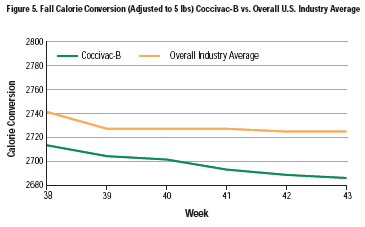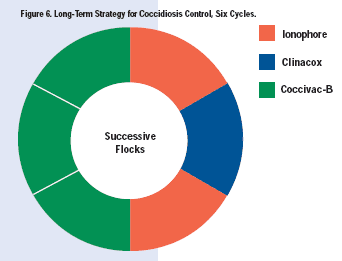Look at the Big Picture
Industry performance data show birds vaccinated with Coccivav-B perform as well as or better than other programs
 |
You're considering adding a coccidiosis
vaccine to your management
program, but you're wondering how broiler performance
will stack up against other strategies
you've used.
Wonder no more.
Now, performance data from an
industry reporting service in the United
States show that when growers include
Coccivac-B in their programs, they can
achieve results equal or superior to
other strategies.
In the study, performance of birds
vaccinated with Coccivac-B for coccidiosis
was compared to birds of similar
weight that used standard anticoccidial
The study ran from week 29 (mid-
July) to week 43 (early November).
Each week or "data point" in the
accompanying figures represents the
average of 19 to 23 vaccinated complexes
versus 28 to 30 complexes that
used standard in-feed anticoccidial programs.
For complexes that used
Coccivac-B, mean bird weights were
6.0 lbs at week 29 to 38, and 6.3 lbs at
weeks 38 to 43.
How do birds compare?
Investigators first looked at how the
performance of birds compared during
the summer months, focusing specifically
on live cost per pound of meat as
well as calorie conversion.
Birds that received Coccivac-B -
even though they had an average
weight of about 6 lbs "performed
better than similar-weight birds using
standard anticoccidials. That was true
even for birds on standard anticoccidials
that weighed 5.2 to 6.0 lbs or
greater than 6 lbs.
During cooler fall weather, performance
for all classes of birds picked up,
partly due to reduced stress from the
hot weather. Performance for birds that
were vaccinated with Coccivac-B was,
again, superior to the overall industry
average.
Dr. Rick Phillips, director of worldwide
poultry technical services for
Schering-Plough Animal Health, says
it's also important to keep in mind that
hot weather continues to exert a major
impact on performance, regardless of
whether birds are vaccinated with
Coccivac-B or on standard in-feed
anticoccidials, or whether they are
housed in traditional growing environments
or housed in modern environmentally
controlled houses.
 |
Think long-term
 |
These new data, he stresses, give
direct-line comparisons at the same
time against variable programs. "It
shows that Coccivac-B is equal to or
superior to those traditional programs,
even though the numbers might not be
quite as good in the summertime as in
the fall. That's only natural, due to the
heat, the humidity and major temperature
fluctuations."
Phillips stresses also that in terms of
optimizing control of coccidiosis, integrators
would do well to think longterm,
rather than confining their focus
to immediate needs or concerns.
"We feel strongly that integrators
can often improve long-term performance
by using Coccivac-B in an annual
program," he adds. "That can be a big
help in renewing the sensitivity of the
house coccidial population to the most
effective anticoccidials."
Today's Rotation Strategies
The poultry industry is no stranger to rotating products for
maximum performance. But with coccidiosis vaccination
being used by most mainstream producers for at least a part
of their program, the game plan has changed considerably.
The process generally starts with discontinuing a worn-out
ionophore and using Clinacox (diclazuril) in the starter feed
only, for one cycle. Clinacox zaps the wild strains of coccidia
that have been brewing over the years and effectively cleans
up the house.
In the following cycle, producers switch back to an
ionophore for one cycle before rotating to Coccivac-B,
a vaccine that uses a controlled, balanced dose of coccidia
oocysts to stimulate natural
immunity for the life of the
bird. The vaccine is used
for at least three cycles.
Coccivac-B also seeds
the house with an older
generation of oocysts that
are highly susceptible to
salinomycin and other
older anticoccidials.
 |
After three or four cycles
with the vaccine "a
period when producers
often see performance
improvements in successive
flocks "integrators
have the option of either
staying on the vaccine or switching back to an ionophore
and starting the three-product rotation again. (See Figure 6).
"In a sense, using a live-oocyst vaccine is like putting an
operation's coccidia populations in a time machine and sending
them back in history more than 50 years," explains Dr.
Rick Phillips, DVM, of Schering-Plough Animal Health
Corporation. "After three or four cycles with the vaccine, the
older ionophores act young again and do a much better job
keeping coccidia in check "as long as they're not overused."
Source: CocciForum Issue No.8, Schering-Plough Animal Health.







